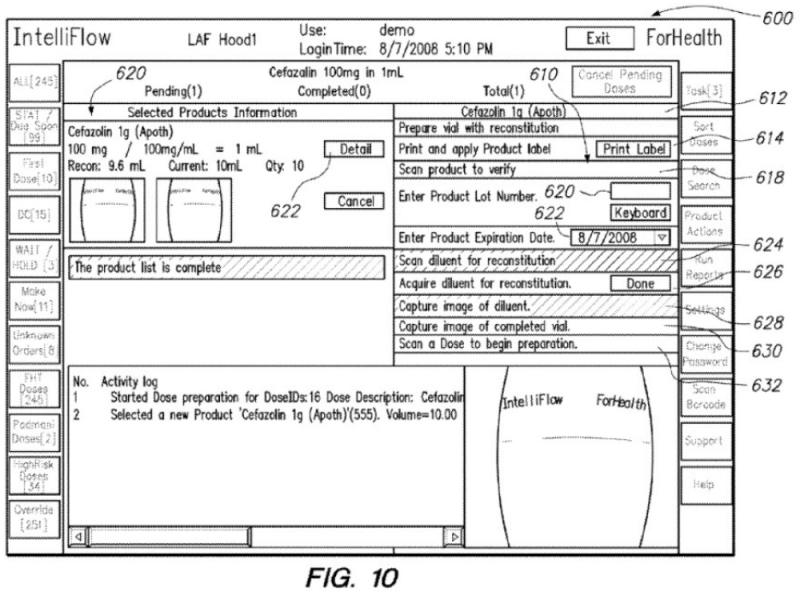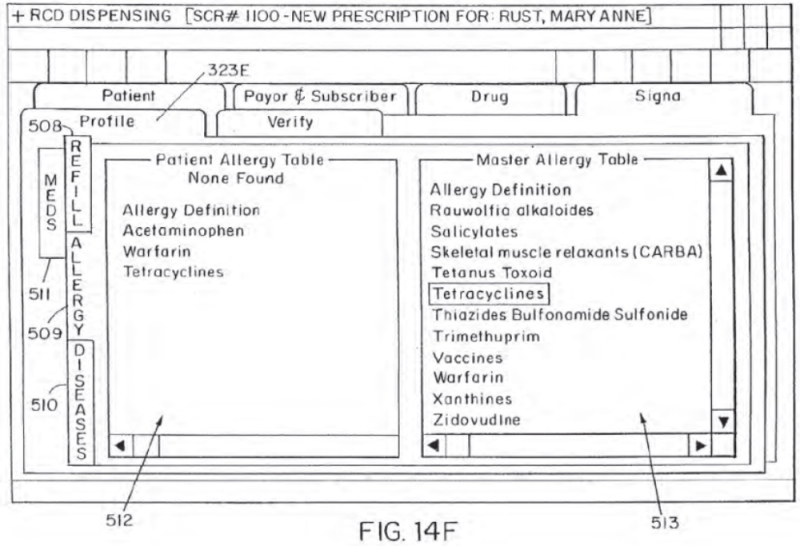In Becton, Dickinson & Co. v. Baxter Corp. Englewood, the Federal Circuit overturned a decision by the Patent Trial and Appeal Board (PTAB) in an inter partes review that claims in the challenged patent were not invalid for obviousness.
The patent at issue, U.S. Patent No. 8,554,579, is directed to telemedicine methods and particularly to methods for preparing patient-specific doses of pharmaceuticals. Claim 8 was considered representative by the Court:
8. A system for preparing and managing patient-specific dose orders that have been entered into a first system, comprising:
. . .
a dose preparation station for preparing a plurality of doses based on received dose orders, the dose preparation station being in bi-directional communication with the order processing server and
having an interface for providing an operator with a protocol associated with each received drug order and specifying a set of drug preparation steps to fill the drug order, the dose preparation station including an interactive screen that includes prompts that can be highlighted by an operator to receive additional information relative to one particular step and includes areas for entering an input;
. . . and wherein each of the steps must be verified as being properly completed before the operator can continue with the other steps of drug preparation process, the captured image displaying a result of a discrete isolated event performed in accordance with one drug preparation step, wherein verifying the steps includes reviewing all of the discrete images in the data record . . . .
The claim terms at issue, both of which are recited in representative claim 8, are "highlighting" and various forms of the concept of "verification," as indicate in the claim as set forth above. Becton, Dickinson asserted three prior art references in support of its IPR challenge sounding in obviousness: U.S. Patent No. 8,374,887 ("Alexander"), U.S. Patent No. 6,581,798 ("Liff"), and U.S. Patent Publication No. 2005/0080651 ("Morrison"). The Board had found that the skilled artisan would have been motivated to combine the Alexander and Liff references, and even the combination of all the references. Similarly, the Board found Baxter's evidence of secondary considerations to be weak, according to the Federal Circuit's opinion. Nevertheless, the Board found that the Alexander reference, taken alone, did not render obvious the "verification" limitation, or that the combination of the references did not render obvious the "highlighting" limitation of the challenged '579 patent claims.
The Federal Circuit reversed the Board's determinations, in an opinion written by Judge Dyk, joined by Judges Prost and Clevenger. The panel first addressed the "verification" limitation. According to the Court, the Board's application of its construction was not supported by substantial evidence. Specifically, the Court held that the Board erred in concluding that the primary reference, Alexander, only disclosed that the remote pharmacist may verify but not that she must verify "each and every step before the operator is allowed to proceed." The opinion states that in the panel's view "'may' does not mean 'occasionally,' but rather that one 'may' choose to systematically check each step." This is significant because the Court found that in the context of the prior art Alexander specification "[t]here is no significant difference between that teaching of Alexander and the '579 patent's verification requirement, which the Board construed as requiring that 'the system will not allow the operator to proceed to the next step until the prior step has been verified.'" The Court rejected Baxter's arguments to the contrary that unverified prescription filling was within the scope of the Alexander teaching (which argument was based on deposition testimony of Becton's expert), nor that use of the term "the system" in the Alexander process implicated a mechanical "hard stop" to the prescribing function, the Court stating that "[n]othing in the construction requires a mechanical stop as opposed to requiring authorization from a pharmacist to continue." Accordingly, the panel held that the Board's determination to the contrary was not supported by substantial evidence.
With regard to the "highlighting" limitation the opinion notes that this limitation is tied to embodiments having "an interactive screen that includes prompts that can be highlighted by an operator to receive additional in-formation relative to one particular step," as illustrated by Figure 10 of the '579 patent:

The Court's understanding of the Board's construction of this term was that "the only missing element of this limitation [in the Alexander reference] is the ability to highlight prompts to receive more information concerning drug preparation steps." And this feature was disclosed in the Liff reference in the panel's assessment (albeit in the physical rather than the virtual, computer realm; as stated in the opinion the system disclosed in the Liff reference comprises "a cabinet adapted to store a variety of prepackaged pharmaceuticals in a plurality of bins for filling patient prescriptions"; the Liff system was illustrated by Figure 14F of that patent:

The Board had characterized its non-obviousness determination based on the highlighting limitation to be a "close case"; the Court disagreed. To the panel, the Liff patent's teachings regarding highlighting for one purpose (i.e., patient characteristics) clearly would not have precluded the skilled worker from applying the highlighting function to another feature (e.g., information regarding the prescription order). In the panel's view, their decision was predicated on the Supreme Court's teachings in KSR Int'l Co. v. Teleflex Inc., 550 U.S. 398, 416 (2007), that "[t]he combination of familiar elements according to known methods is likely to be obvious when it does no more than yield predictable results." In addition, the panel relied on KRS for the principle that "[a] person of ordinary skill is also a person of ordinary creativity, not an automaton" with regard to the question of whether the "additional information that might be relevant" was limited to what the Liff reference expressly disclosed.
In an interesting aside, the Court considered the issue of whether the Alexander reference was properly prior art under 35 U.S.C. § 102(e), because all claims in that patent were subsequently cancelled in an IPR. Baxter argued that this eliminated the statutory requirement that the reference be "granted" and hence § 102(e) no longer applied. The panel rejected that interpretation of the statute, saying that the Alexander reference satisfied the statutory terms because "the grant[] had occurred" and that the statute did not require the patent be currently valid to qualify as prior art.
Finally, the panel addressed Baxter's secondary considerations evidence, agreeing with the Board that it was "weak" and did not rebut the prima facie case.
The Court's invalidation outcome is rare with regard to an obviousness determination by the PTAB because it is equally rare that the Board does not amass sufficient evidence to be considered substantial and thus is not entitled to deference under Dickerson v. Zurko. But where, as here, an IPR petitioner can demonstrate sufficient paucity of factual basis supporting the PTAB's non-obviousness determination, the outcome is unsurprising no matter how infrequent it may be in practice.
Becton, Dickinson & Co. v. Baxter Corp. Englewood (Fed. Cir. 2021)
Panel: Circuit Judges Prost, Clevenger, and Dyk
Opinion by Circuit Judge Dyk